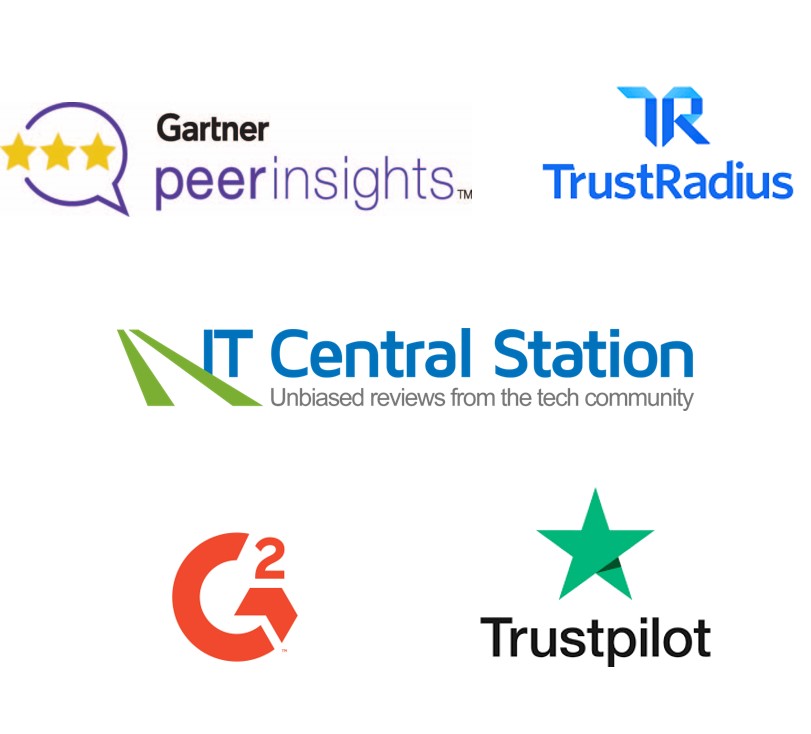
Just as we use Amazon reviews for shopping, Trip Advisor for travel and Yelp for restaurants in the consumer world, over the last five years there is the emergence of customer reviews in the Business to Business (B2B) tech world.
Today buyers increasingly measure the value of products and services not just by features and benefits, but their experience throughout their journey; buying process, deployment times, ease of use and most importantly post sale support.
All products claim to be fast, eco-friendly and efficient. Competitors catch up quickly with product features. This type of commoditized feature similarity makes it difficult for marketers to differentiate.
It is paramount to build a brand and there is no better way for the customers that buy from you become your brand ambassadors recommending you.
Virality (word of mouth) is more important and relevant for B2B companies than ever before. Buyers trust that their peer’s or colleague’s validation.
Companies talk about Customer centricity but for real do not use Customer Voice earlier in the buyer’s journey. Sales teams think about customer references when they are closing a deal or just passively earlier while listing customer references in the RFP (request for proposal).
With the right customer review strategy, you can get customers to do your selling. You can capture your customer’s insights in the reviews addressing all the steps in the buyer’s journey. You can turn skeptics to advocates.
In this blog, you will learn on how to harness the Power of Customer Reviews to amplify Customer Voice. I cover
- What are B2B Customer Reviews?
- How do B2B Customer Reviews work?
- Why B2B Customer Reviews is a popular emerging reference asset?
- 11 Practical ways to re-purpose your customer review content?
- Criteria to use to select a review company?
- B2B Customer Review Industry Analysis
- Summary and Conclusion
What are Customer Reviews?
Review companies host a customer voice platform that allows users to share their experiences of product or service they use. It is a multi-sided business model that serves both vendors as well as their prospective buyers.
Unlike the B2C counterparts, all customer reviews are validated by a human being and reviewers are authenticated by Linkedin profile or user profile ID.
Customer Reviews help not only the prospective buyers doing their own vendor research online but also the vendors in the sales and marketing channels to increase their win rate.
How does it work?
- The vendor collaborates with the review company to come up with the list of questions on key topics for customer to address. Some peer review companies do not provide this option.
- The vendor informs the customers that they are engaging the review company as third-party administrator to get customer feedback.
- The vendor provides their customer contact list to the review company. The review company conducts campaigns consisting of 2-3 emails over 7 to 10day period.
- Some vendors hold challenges in their advocacy platform, or their customer success managers reach out to their customers.
- Customer writes about their experiences and can choose to be anonymous or disclose their identity and company they work.
- Some review companies do in person interviews at company/ trade events or conduct phone interviews. The interviews are transcribed and approved by reviewer before publication.
- Review company authenticates every reviewer, optimizes for content quality and data integrity and does not alter negative content before publication.
- Review company gives the reviewer incentive of $25 to $50 in form of gift card or swag. The response rates are between 3% to 5% despite incentives.
- Review companies provide functionality to thank or ask additional follow up questions to the customer to get deeper insights.
Why Customer Reviews is an emerging reference asset?
Customer marketers use different ways to capture customer stories. They may be case studies, videos, customer quotes, press releases, branded analyst customer case studies, white papers or logo usage. Each reference asset has its pros and cons.
Case studies is the most preferred reference asset. Prospective buyers like case studies as they are comprehensive, evidence-based, and focused on the big picture.
They help understand the business problem, the vendor’s solution and results achieved. They are prime examples from the buyer’s own industry or use case. They are also more influential with executives.
On the flip side, buyers often question the credibility because the information is usually collected, compiled, and presented by the vendor themselves, and so are often inherently biased in a way that favors the vendor.
They are expensive, time consuming and takes on average 3 to 6 months to publish as it needs to pass through legal hoops on both sides for approvals and this causes considerable delays.
Customer Reviews help solve this problem as they provide a different level of authenticity and trustworthiness. They have good and bad experiences and are more candid.
On the flip side, you need internal buy-in from sales account teams to provide their customer contact lists. It may take time to build a critical mass but once established it is easy to scale. You need to work with multiple review companies, which may be time consuming.
Two research firms corroborate that review websites are being widely used for vendor evaluation.
Forrester surveyed 1001 US and European business technology decision makers and they value peer reviews websites higher than branded analyst customer case studies.

In their 2019 B2B Buyers Survey, Demandbase found that buyers are increasingly using reviews sites to learn about vendor offerings.

If you are a startup or small to medium size company, you might not be in the radar of the industry experts, analysts and influencers community. It becomes quintessential that these companies have a review strategy.
The analyst and industry experts are also using these review sites to get know the company’s customer feedback. It helps to qualify for the Gartner Cool Vendor and Forrester New Wave categories.
As Russell Rothstein, CEO of IT Central Station puts
“B2B reviews is an important emerging customer reference asset, especially when the reviews are in-depth with substantial content. What enterprise tech buyers want is smaller number of reviews relevant to them, that they can actually believe and get unbiased insights.”
11 Practical ways to re-purpose your customer review content?
It is recommended to have a multi-pronged strategy and work with at least 2 to 3 review companies. Once you have developed a critical mass you can repurpose in following ways
1 Custom Review Quote widgets in your company website- You can use the review company’s custom quote widget CSS code or have company’s IT team develop a widget slider that can showcase your multiple review company quotes at once. It is most effective to use quotes relevant to specific content in that webpage.
For example- If you have new product launch web page or specific industry vertical that you are targeting, quote widgets help showing the customer proof points and validation.
2. Social Media Posts and Blogs- You will be surprised that some reviewers are so enthusiastic and write such detailed reviews spanning 700 to 1000 words. They are great advocates that you might get 10 to 15 quotes from the review. You can share such reviews in social media sites such as Linkedin and Twitter.
You can also leverage review quotes in company blogs.
3. Review Company Accolades & Reports- Many of the popular review sites have their own awards/accolades/rankings based on their own methodology. Some of popular accolades are the Gartner Peer Insights Customer Choice Distinction, TrustRadius Top Rated Awards and IT Central Station Rank Badges.
Many of these companies create competitive reports in a business technology markets based on the reviews and you can buy the reprints if you are leader in that category. They can be used for demand generation related activities.
4. Reference Candidates Program- participate in advocacy/reference activities- Some review companies have reference candidate programs where the customer (reviewer) can opt in to participate in the vendor customer reference program. This is beneficial as you can feed these candidates into your advocacy platforms as well as reach out to them to participate in webinars or analyst/ customer reference calls.
5. Building an internal Quote repository- Some review companies have proprietary quoting platforms to select quotes from the reviews and tag them based on your preferred categories. This is beneficial as you can create a repository of quotes that your marketing and sales teams can leverage.
For example- You can create tags for use case, product features, specific competitors, support and desired marketing messaging. You can also tag the negative content comments for developing new product features.
6. Email Nurture Campaigns- Review quotes and links to respective reviews can used in specific targeted email nurture and account-based management campaigns. These are helpful while targeting specific industry verticals and use cases.
7. Inside Sales/ Sales Development Reps (ISR/SDR) leveraging Reviews Webpage Visitor Intelligence- Some of the review companies provide the vendor with visitor intelligence to their pages such as the company name, location, title, number of pages viewed, and their competitor’s pages viewed in a session based on the IP address.
This information is very useful for ISR/ SDR to compare with their current leads list that they are working on. If there is a match, they can have more productive and targeted conversations. They can also highlight the competitive differentiation based on the visitor intelligence data.
Don’t be surprised if you notice that your competitors and your partners monitoring and viewing your reviews on a regular basis.
8. Retargeting Ads in Review Company’s website- Review companies provide the service of allowing the vendor to place retargeting ads in their website. The click through rates vary depending on the size of the images and marketing messaging.
9. Training Sales team to use competitive intelligence features- Review companies in the vendor’s reviews pages provide many filters such as industry vertical, company size, reviewer title and location. They also provide functionality that you can compare up to 2 competitors based on different attributes.
For example- A sales rep in Zoom is selling to Finance enterprise prospect and is competing against Cisco and Microsoft. The Zoom Sales rep can share with the prospect the web URL of all Zoom reviews on Gartner Peer Insights comparing Cisco & Microsoft based on willingness to recommend, product capabilities and customer experience.
This feature is available publicly and for free in most review companies. This is very powerful if you have higher ratings than your competitors. You need to invest the time to train the sales team to use this feature.
10. Track Customer Reviews Revenue Influenced $ value- You can pull a report of the closed won opportunities from your CRM (Customer Relationship Management) in the recent 6 to 12 months and compare it with the review company visitor intelligence report in last 12 months.
You can match all the companies that read your reviews and finally ended up buying from your company. You can track Revenue influenced $ value.
This metric is useful to showcase the value of your Reviews Program with Marketing and Sales Executive Management.
11. Customer Reviews drive Search Engine Optimization (SEO)- Once you have built a critical mass of reviews working with the review company, whenever a prospect or customer types “Your Product name reviews” in a search engine, your reviews and ratings appear among the top searches in the first page.
You need to ensure that your website widgets are also Search Engine Optimized as the review quote may contain keywords relevant in your marketing messaging.
3 Criteria to use to select a review company
Here are key criteria that you should you use
1 Select Quality of Reviews rather than Quantity of Reviews- Review companies will market the total number of the reviews, time on site, bounce rate, number of products and categories in their website. What matters is the number of reviews and number of competitors present in your product/ market category in their website?
You need to know average word count per review (good word count is 400 to 600 words). B2B buyers are different from B2C buyers. They want more in-depth reviews and want to know the negatives (cons) of the product.
No product is perfect and negative feedback can used to an advantage as part of Customer Listening and make product improvements.
2. Ask about the type of campaigns offered to collect reviews- Some review companies conduct email campaigns where they have 5 standard questions and then give the vendor the opportunity to ask 4 customized questions.
This is truly beneficial as you can ask customers questions on topics that you really want to have more insights.
The key is asking the right questions such as inhibitions about the buying decision, business outcomes, post-sales support experience as well as specific features that you want to promote.
You need to use behavioral psychology to ask the right question to trigger the reviewer to think and write a more in-depth review and better word count.
Remember the response rate to your email campaigns is only 3 to 5%. You and I may be in the 95% who don’t review products, but the people who do are passionate.
A few companies conduct in person interviews in your customer or trade events. They generally have 1 or 2 personnel, who interview your customers that visit your booth in a trade show.
They have standard and custom questions as well and speak with customer for 5-7 minutes recording the conversation via the personal digital assistants. They also do phone interviews if you provide the customer contact information.
They transcribe the interviews and get approval from the reviewers prior to publication. This is beneficial as many customers are more comfortable speaking with a person than writing a review.
3. Tools and functionalities to repurpose the review content- While it is helpful that the reviews help the prospect/ customer in their product evaluation, you need to make sure that the review company provides you tools to repurpose the content in your sales and marketing channels.
You need understand the functionality such as custom widgets, quoting platform, visitor intelligence, filters and reference candidate programs. It is also important to check the User experience of the review company website.
Ask the review company how they generate their traffic to their website- organically vs inorganically?
B2B Customer Review Industry Analysis
Like in any given industry, there are the Davids and the Goliaths, the B2B review industry is dominated by Industry Analyst Advisory firm Gartner and the Davids (disruptors) independent companies like G2 (formerly G2 Crowd), TrustRadius, Trustpilot and IT Central Station.
Salesforce Apps Exchange has its own reviews platform for their own ecosystem, which is popular among Salesforce users.
Gartner is global research and advisory firm with client base of 15,000 organizations in 100 countries and excellent end user relationships. Gartner was quick to see the B2B reviews trend and embrace it.
They have been very strategic and developed a moat, without giving the disruptors a strong advantage. Gartner operates four independent brands- Gartner Peer Insights focused mainly on enterprise customers and three acquisitions Software Advice (2014), GetApp (2015) and Capterra (2015) focused on small and medium customers.
Gartner has access to 100,000+ end user base for Peer Insights brand and the reviews are feeder to the Gartner Analysts community. Gartner Peer Insights does not offer marketing integration and analytics capabilities and customized questionnaires. They are using brand, research expertise and financial might to make Peer Insights successful.
Vendors need to create a presence in Peer Insights as the Gartner analysts use the customer feedback that helps in competitive positioning in the Magic Quadrant. Gartner Peer Insights has the Voice of Customer quadrant and Customer Distinction report that vendors can buy reprints.
The independent review companies are mostly Venture Capital (VC) funded – G2 (Linkedin & Accel Partners-$100M), TrustRadius (Mayfield, Live Oak, New Coast, $25M), TrustPilot (Denmark based, $173M includes B2C) and IT Central Station (Israel & NYC based, privately funded).
All the independent review companies depend on the vendor companies to drive reviews to their platform. Different markets have different review volumes. They have several product categories that can be confusing for the vendors. They also offer similar quadrants like the G2 grid and Trust Maps.
The only competitive differentiation among the independent vendors versus Gartner is the word count per review, customized questionnaires for campaigns and tools they offer for repurposing review content.
Fortunately, the B2B reviews industry does not have the fake reviews problem as the B2C counterparts as there is human authentication for every review.
Review companies are plagued with the issue offering financial incentives such as gift cards ($25 to $50) to lure the customer to write a review.
Since the response rates for writing reviews is about 3 to 5%, I argue incentives offered is necessary and should be tied to word count and the quality of review provided.
Vendors need also leverage other sources such as holding challenges in their advocacy platform or have their customer success managers/account team reach out to their customers to write reviews.
SUMMARY AND CONCLUSION
B2B Reviews is going to continue to gain traction.
The independent review companies will be able to succeed if they are able to create markets categories with sizable number of reviews where the 3-5 major leading competitors are present.
They also need to have provide sound value proposition/ training for repurposing the review content to the vendor sales and marketing teams.
Gartner needs to provide more offerings to the vendor to repurpose the review content as well.
The other big research and advisory firms such as IDC, Forrester or Ovum may acquire the independent review companies. Time will tell as they have stayed away from reviews so far.
As for the vendors, Vinay Bhagat, CEO of TrustRadius sums up it well
“Smart companies don’t just accumulate reviews online – they weaponize them in their own marketing and sales channels! But the value of reviews extends well beyond engendering trust and removing friction with buyers.
Long-form reviews can provide authentic feedback as to how you can improve your product. Feedback is unvarnished, immediate, and statistically significant, if a program is run at scale.
Thank you for taking the time to read my blog. Please feel free to share, comment or like.
-
Previous Post
Confessions of a father of a child with disabilities




